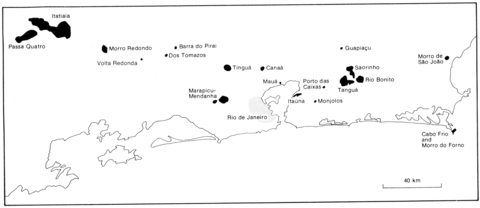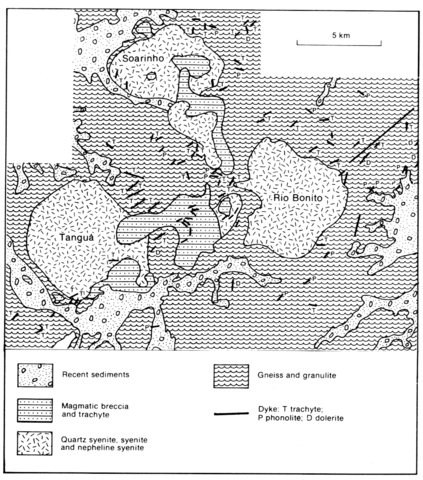stripes
This approximately circular intrusion 6-7 km in diameter is cut by plugs of intrusive breccia, and emplaced in Precambrian biotite gneisses and granulites, close to Saorinho and Rio Bonito (Fig. 2_206). Saturated and slightly oversaturated pulaskites are the dominant rock types in the outer parts of the intrusion and pass into nepheline syenite in the higher central parts. Large masses of magmatic breccia and trachyte cut the complex on its western and southern margins and contain blocks, up to 1 m across, of trachyte, phonolite, syenite and gneiss set in a trachytic matrix; silicification is widespread. Pseudoleucite rocks are found along the northwestern margin and occasionally in the northeastern and central parts and occur as microsyenite dykes. Individual pseudoleucites reach 15 cm in diameter and locally may occupy 30% of the rock by volume. Analyses of pseudoleucite are given by Valenca and Edgar (1979). Dykes of phonolite and trachyte are abundant around the intrusion. Ipitangas is a small alkaline magmatic breccia body 1.5 km south of Tangua with extensive development of chalcedony within it. Fluorite- and chalcedony-rich veins associated with trachyte dykes are abundant in magmatic breccias and the adjacent gneisses along the southern border of the intrusion.
LIMA, P.R.A. dos S. 1976. Geologia dos macicos alcalinos do estado do Rio de Janeiro. Semana de Estudos Geologicos, Itaguai: 205-59.
Valenca and Edgar, 1979;
VALENCA, J.G. and KLEIN, V.C. 1984. Complexos alcalinos situados a leste da Baia de Guanabara, Rio de Janeiro. Anais Congresso Brasileiro de Geologia, 33: 5317-33.
VALENCA, J.G. and KLEIN, V.C. 1984. Complexos alcalinos situados a leste da Baia de Guanabara, Rio de Janeiro. Anais Congresso Brasileiro de Geologia, 33: 5317-33


